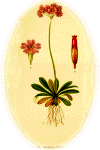|
Just be thankful they’re small, says Peter Marren.
These plants can wipe out millions of insects in a single summer’s
day
If we didn’t have sundews and pitcherplants as living examples,
the idea of a carnivorous plant would sound like science fiction,
about as improbable as an animal with leaves. Plants just don’t
seem designed to eat meat. They have no teeth to start with, nor
a stomach to hold the food while it is digested. They have no
legs to run after their prey, nor, for that matter, any eyes to
spot the prey in the first place. Plants, so zoologists claim,
exist in order to be eaten by animals. Well, a sundew, if it had
a brain, would beg to differ.
For a flowering plant to eat meat, certain modifications to the
basic design of roots, stems and leaves are needed. Since, despite
John Wyndham’s triffids, no plant has ever been able to pull
up its roots and walk, it needs some means of attracting and then
trapping animals. It also needs a cocktail of corrosive fluids
to break down meat into its component sugars and proteins. And
even if a plant cannot have a stomach, it will nonetheless need
some sort of enclosed breadbasket to bring the food into contact
with digestive glands embedded in the leaf.
F ortunately attracting insects comes naturally to a flowering
plant. Scents, colours and guide-marks all help to lead the insect
to its sugary reward, whilst the flower quietly dumps a load of
pollen on its back. Some flowers, like the catchflies, trap the
insect for a time to ensure it does its unwitting job properly.
Sometimes the insect stays trapped and dies. Though this is an
occupational hazard of a pollinator, these insects do not become
food for the flower. No flower, in fact, can kill and then eat
an insect. Because they need to be light enough to be carried
on a thin stalk, they cannot afford to carry the necessary glands
and glues. Instead, carnivorous plants turn to those tough, versatile
workhorses, their leaves.
Sundews are our best-known meat-eating plants. Their red, jewel-like
leaves use bright colours and twinkling droplets of goo to attract
their prey and then seize hold of it with the combined powers
of superglue and acid. Butterworts work in much the same way,
using their thick, sticky leaves to trap small insects. Both kinds
of leaf are sensitive, and use speeded-up growth to curl around
larger prey to form a sort of vegetable stomach. A large sundew
can digest insects as big as butterflies and damselflies. Our
third group of native meat-eaters, the aquatic bladderworts, are
really stripped-down plants, lacking roots and true stems, while
even the leaves are reduced to threads. Apart from their occasional
yellow flowers, bladderworts look more like floating algae than
a vascular plant. They do, however, have inbuilt
‘stomachs’ in the form of tiny bladders, scattered among
the
|
leaves, which have the power to suck in water-fleas and other
tiny animals. A bladderwort plant can consume up to a quarter
of a million of them in a single season.
These un-plantlike modifications come at a price. While orthodox
plants devote nearly all their energy into producing leaves and
flowers, carnivorous plants have to devote most of it to building
their traps. However deadly they are to flies and water-fleas,
their ‘business plan’ means they are less efficient
than other plants, with feeble roots, and are able to flower only
when things are going well. Sundews and butterworts cannot grow
in grass or dense vegetation, nor indeed in fertile soil. Their
compromising life-style confines them to wet, infertile places
with no over-shading growth. Their idea of a perfect home is a
peat-bog with no soil but plenty of moss cushions and shallow,
acidic pools. Damage or remove the bog and you destroy the abode
of Britain’s three species of sundew, two kinds of butterwort
(plus a third in Ireland) and six bladderworts (the species are
relatively few, but even so we are in the European big league
for meat-eating plants).
Our carnivorous plants are, alas, among the most rapidly declining
plants, not only in Britain but in Europe as a whole. The new
Atlas of the Flora of Britain and Ireland will show that
the range of some species has contracted by up to a half within
living memory. The most obvious reason is habitat destruction.
You would need to be a very cunning bladderwort to survive at
England’s largest lowland bog, the much-abused Thorne Moors.
More insidious is the enrichment of much of our soil and freshwater
with nitrogen and phosphorus. Enriched conditions produce lusher
vegetation, murky water and increased fungal attack, all of which
spell doom for meat-eating plants. Fortunately they seem safe
enough for the moment in their heartlands, the blanket bogs of
north-west Britain.
Where they still occur, carnivorous plants can dominate their
patch. In places like the New Forest you can count several hundred
sundew plants in a square metre, or scoop up handfuls of filmy
bladderwort. The number of insects they consume, wrote Darwin,
must be prodigious. Yes, indeed. A Norfolk naturalist, F.W. Oliver,
once witnessed the result of a vast swarm of migrant butterflies
that had fatally settled to feed on what they took to be drops
of nectar, candy from the Gods. It was, in fact, a large patch
of great sundew Drosera anglica. Soon all that was left
were pairs of white wings, stuck to the leaves and painting the
ground white. Oliver estimated that six million butterflies had
been caught and consumed within shortly after dawn on that hot
summer’s day. They might not run, jump and snap their teeth,
but there are times when plants can teach the animals a thing
or two about appetite. It should make us thankful that chemistry
prevents them from growing to the size of tigers, or oak trees.
|


